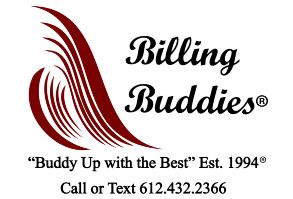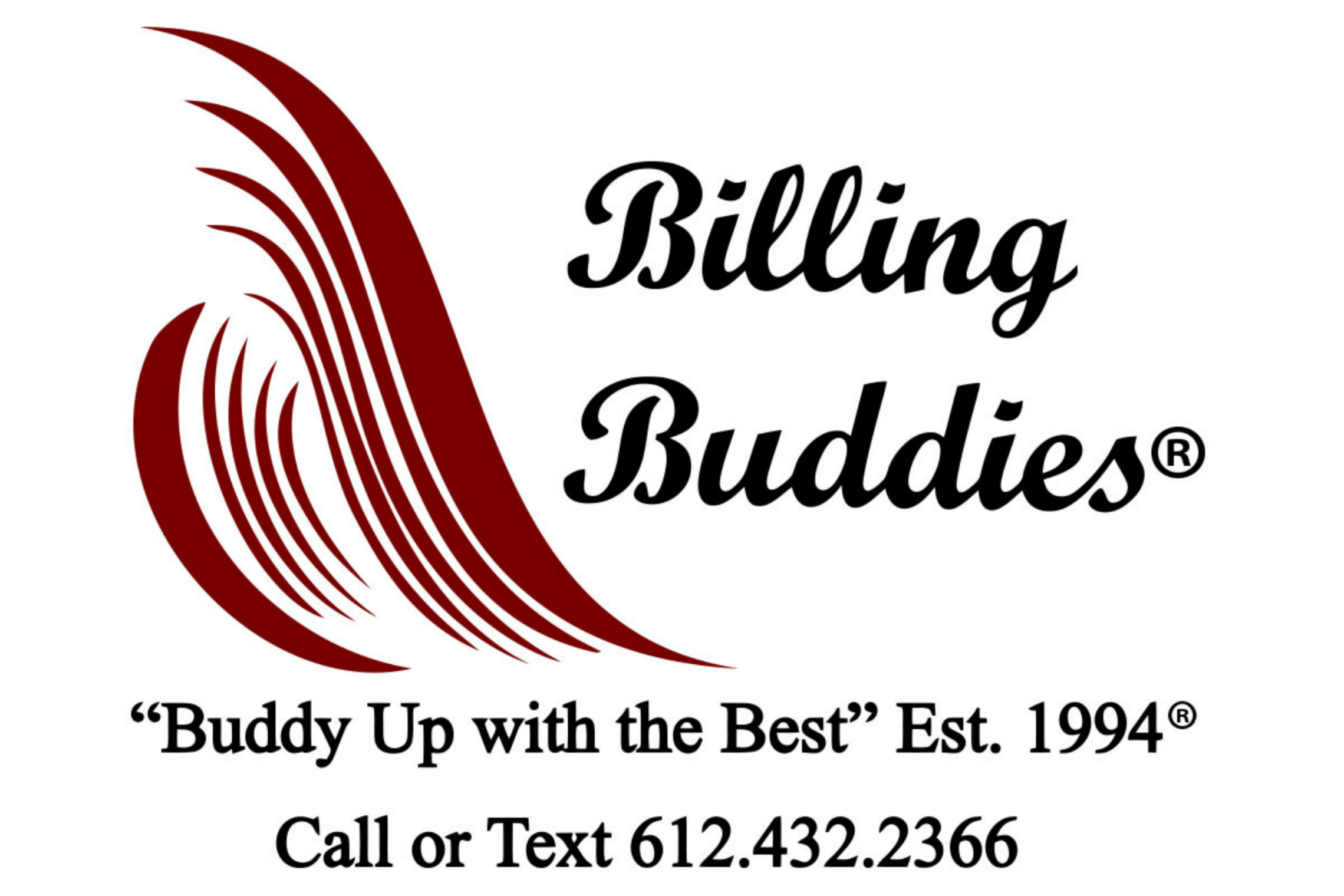Episodes

Sunday Apr 07, 2019
Six Myths of Chiropractic Billing
Sunday Apr 07, 2019
Sunday Apr 07, 2019
Six Myths of Chiropractic Billing
Welcome to Billing Buddies YouTube and Podcast series.
In this episode, we will be discussing six myths of chiropractic billing. Billing Buddies has been doing chiropractic billing for 25 years and over the years have experienced doctor offices having misinformation. We will share six areas that are commonly misunderstood.
Myth # 1: Chiropractors need X-rays on all Medicare patients.
Answer: On January 1, 2000, Medicare gave the option to doctors to take X-Rays or do a PART exam to demonstrate subluxation of the spine. Review your Medicare LCD (Local Coverage Determination) to see how to properly document a PART exam. The LCD’s can be found at your local carrier’s website or there’s a link at www.cms.gov.
Myth # 2: Chiropractors need an ABN on all Medicare patients.
Answer: ABN’s (Advanced Beneficiary Notice) are only required on covered Medicare services that don’t meet Medicare coverage guidelines. ABN’s should be given on a case by case basis. For example: if you are providing a 98940, 98941 or 98942 service and the patient is on maintenance care, an ABN should be presented to the patient.
Myth # 3: Chiropractors can’t charge an exam fee for Medicare patients.
Answer: Charging practices need to be uniform for all patients. Practices need to charge Medicare patients for exams even if they are not covered by Medicare. By failing to charge Medicare patients, practices are profiling patient segments and charging differently which is prohibited by CMS.
Myth # 4: Chiropractors can opt out of Medicare and charge Medicare patients directly.
Answer: Chiropractors cannot opt out of Medicare. If a chiropractor does not have a PAR or a Non-PAR Medicare contract, he cannot treat a Medicare patient. The patient needs to be referred to a chiropractor that has a Medicare contract.
Myth # 5: Chiropractors can’t charge for therapy services.
Answer: Charging practices need to be uniform for all patients. If provided, chiropractors need to charge Medicare patients for therapies even if Medicare does not cover them.
Myth # 6: Chiropractors (or any healthcare professional) can write-off hardship balances for low income patients.
Answer: Healthcare providers may write-off balances for hardship if they have a hardship policy and verify income. Healthcare providers must have a hardship policy, verify income and follow uniform hardship guidelines for all patients.
These are the six chiropractic billing myths. This presentation was brought to you by Billing Buddies. Billing Buddies is a medical billing and consulting service established in 1994. We offer services to a variety of specialties across the United States. For more information, please call or text 612.432.2366. Thank you for listening to Billing Buddies YouTube and Podcast Series and remember to “Buddy Up with the Best”, Billing Buddies. Have a great day!

Monday Feb 04, 2019
Changing of the Codes; ICD-10 and CPT Codes
Monday Feb 04, 2019
Monday Feb 04, 2019
Changing of the Codes; ICD-10 and CPT Codes
Welcome to Billing Buddies YouTube and Podcast series.
In this episode, we will be discussing the annual changing of the codes; particularly, the ICD-10 and CPT codes.
Healthcare professionals, medical billers and payers rely on several types of codes sets in order to communicate pertinent information about patients. These code sets include TOS (Type of Service); POS (Place of Service), and NPI (National Provider Identifier) to name a few. In this writing, I will address the codes that are updated annually, the ICD-10 and CPT Codes.
The ICD-10 codes are specifically called either ICD-10 CM or ICD-10 PCS. The ICD-10 CM codes are used for all healthcare settings except hospital inpatient settings where ICD-10 PCS codes are used. For the purposes of this writing, I will be referring to ICD-10 CM codes and abbreviate them to ICD-10. Each year on October 1st, the ICD-10 codes have revisions, additions and deletions. These codes are copyrighted and maintained by the World Health Organization. The ICD-10 codes define the diagnosis of the patient. There are many free resources online for healthcare professionals and billers to find the updated codes. One of my favorite sites is the www.icd10data.com. On this site, you can see the added, deleted and revised codes. Codes with red arrows next to them signify codes that are non-billable/non-specific codes. These codes cannot be used for billing purposes. Codes with green arrows next to them signify codes that are billable codes. It is important to note that diagnosis codes should be coded to the highest specificity. Besides free online resources, ICD-10 coding books may also be purchased from several publishers.
CPT codes are copyrighted and maintained by the AMA. CPT is the acronym for Current Procedural Terminology. The CPT codes define the services and procedures received by patients. Each year on January 1st, the CPT codes have revisions, additions and deletions. The CPT coding updates need to be purchased either in books or an online subscription. Many of the CPT codes are addressed in payer policies and can be read for free online, but for a complete resource, it is best to purchase an updated manual or online subscription.
It's important to note that HIPAA defined which codes sets are used to communicate. Prior to HIPAA, many payers defined their own codes sets. For example, in some specialties, like chiropractic, codes varied by payer. Medicare, worker’s compensation and commercial insurance each had their own code sets. HIPAA streamlined the coding processes by defining one code set for each data element.
In summary, whether you use online resources or purchase manuals, it is important to note that ICD-10 codes update each year on October 1st and CPT codes update each year on January 1st. You want to stay updated to the most current codes to be compliant with your coding and billing and to reduce denials from payers.
This was brought to you by Billing Buddies. Billing Buddies is a medical billing and consulting service established in 1994. We offer services to a variety of specialties across the United States. For more information, please call or text 612.432.2366. Thank you for listening to Billing Buddies YouTube and Podcast Series and remember to “Buddy Up with the Best”, Billing Buddies. Have a great day!

Saturday Jan 05, 2019
Insurance and Credit Cards - Streamlining Your Cash Flow in the New Year
Saturday Jan 05, 2019
Saturday Jan 05, 2019
Insurance and Credit Cards – Streamlining Your Cash Flow in the New Year
Welcome to Billing Buddies YouTube and Podcast series.
In this episode, we will be discussing streamlining your cash flow in the New Year by obtaining current insurance cards and credit card authorizations.
With the New Year upon us, it is especially important to get copies of your patients’ active insurance cards and to get credit card authorizations to secure their accounts with your clinic. These two steps will significantly increase your cash flow. In fact, these two simple tasks will, if followed, increase your cash flow all year long.
Let’s start with the understanding that in the fourth quarter of each year, Medicare and private insurance companies have Open Enrollment. Open Enrollment is when patients can switch coverage for the first of the coming year. Because so many of your patients may have changed insurance coverage the first of the year, it’s imperative to get new copies of insurance cards and to update your billers and billing software with the new policy numbers. Also, if you get denials from insurance companies that coverage is terminated, it is wise to immediately call or send a statement to the patient for the balance, so they will either pay or respond with their current insurance information.
In addition, at the first of the year, deductibles go back into effect. Many clinics are starting to secure the patient accounts with a credit cards on file. Securing a patient account with a credit card on file is a straight forward process. You need to have a form for the patient to complete and sign that gives their credit card information and permission for you to automatically charge their credit card for any balances due. If you need a sample form to secure credit cards on file, please email bonnie@billingbuddies.com and put in the subject line “Credit Card Authorization”. My email again is bonnie@billingbuddies.com spelled out b-o-n-n-i-e-@-b-i-l-l-i-n-g-b-u-d-d-i-e-s.com.
Finally, remember that all year long it is important to verify a patient’s active coverage by getting copies of their current insurance cards and it’s important to secure their account with your clinic by having a credit card authorization on file.
Billing Buddies is a medical billing and consulting service established in 1994. We offer services to a variety of specialties across the United States. For more information, please call or text 612.432.2366. Thank you for listening to Billing Buddies YouTube and Podcast Series and remember to “Buddy Up with the Best.” Have a great day.

Tuesday Dec 25, 2018
Billing Buddies ® Medical Billing and Consulting Services
Tuesday Dec 25, 2018
Tuesday Dec 25, 2018
Need medical billing services? "Buddy Up with The Best" Est. 1994 ® - Billing Buddies ®
Call or Text (612) 432-2366 or email bonnie@billingbuddies.com.

Tuesday Dec 25, 2018
Chiropractic ABN's
Tuesday Dec 25, 2018
Tuesday Dec 25, 2018
Chiropractic ABN’s
Welcome to Billing Buddies YouTube and Podcast series.
In this episode, we will be discussing Chiropractic ABNs.
First, let’s define an ABN. An ABN is an abbreviation of a Medicare form known as the Advanced Beneficiary Notice. Medicare requires providers give an ABN to beneficiaries if the Medicare services they are proposing to deliver is suspected to not be covered by Medicare. If the service is statutorily excluded from the Medicare program, such as exams and therapies for chiropractic care, Medicare does not require an ABN be presented to the patient. Medicare only requires an ABN be presented on services that can be covered under the program such as CMT’s for chiropractic care.
It’s very important when receiving information that you can look up and research the data yourself. For this reason, whenever possible, Billing Buddies will share the source for you to review. The information from this presentation came from www.CMS.gov. You can type ABN in the upper right-hand corner of the screen and search for information on Advance Beneficiary Notices or ABN’s.
Now, let’s take a look at the form. There are several boxes to complete. You can see items A through J are to be completed by the provider and the patient. Let’s review the form.
Field A = Enter the Notifiers Information – This is the clinic and staff member presenting the ABN.
Field B = Enter the Patient’s Name
Field C = Enter the Patient’s Medicare Number
Field D = Enter the Service to be provided. In Chiropractic care, this would be the CMT. You could enter codes 98940 – 98942 in this field.
Field E = Enter the Reason Medicare may not pay. In Chiropractic care, the most common reason would be that the CMT was considered maintenance care. But, review your Local Coverage Determination from your carrier for a complete list.
Field F = Enter the estimated cost. If more than one service is listed in Box D, enter the estimated cost for all services.
Field G = All the fields on the ABN are important, but this one is especially important. Patient’s are required to pick one of the three options. The provider may not complete this portion of the form or it will invalidate the form.
Field H = This is a field where additional information may be provided.
Field I = This requires the patient or representative to sign the form. If a representative signs the form, have the representative write “representative” in parenthesis after his/her signature.
Field J = The patient or representative must date the form when signed.
That completes our ABN video. Thank you for watching. Please subscribe to our channel and like our videos. Also, please comment if you would like other videos presented and suggestions on topics.
Billing Buddies has been assisting providers since 1994 and offers billing services, training and consulting. For more information, call or text 612.432.2366 or email bonnie@billingbuddies.com.

Saturday Apr 28, 2018
Chiropractors Must Bill Medicare
Saturday Apr 28, 2018
Saturday Apr 28, 2018
Chiropractic is one of the specialties that are required to have a contract in order to treat Medicare patients. If a chiropractor does not have a Medicare contract, they are required to refer Medicare patients to another chiropractor who does have a Medicare Contract. This is true even for chiropractic services that are non-covered by Medicare, such as maintenance care.
This rule can be found in Chapter 15 of the Medicare Benefit Policy Manual in Section 40.4. It states; "the opt out law does not define "physician" to include chiropractors; therefore, they may not opt out of Medicare and provide services under private contract."
There has been a confusing notion in the chiropractic profession that chiropractors can have the patient sign an Advance Beneficiary Notice and bill the patient without being a Medicare provider. This isn't true.
The No Opt Out Rule for chiropractors in the Medicare program means a chiropractor can treat a Medicare patient either as a participating provider or a non-participating provider, but either way, the chiropractor has one of the two contracts with Medicare; a participating contract or a non-participating contract.
A Medicare participating contract means the chiropractor has physically signed a contract with Medicare, agrees to abide by all the rules of the program, bills Medicare and accepts assignment from Medicare. A Medicare non-participating contract means the chiropractor has physically signed a contract with Medicare, agrees to abide by all the rules of the program, but has a choice whether or not to accept assignment.
There is one more catch, a non-participating Medicare provider is still limited by how much the patient may be charged. There is a limiting fee schedule whereby the chiropractor may only bill the Medicare patient up to 115% of the allowed Medicare fee even if the chiropractor does not accept assignment and the patient receives payment directly from Medicare.
There is a good handout published by CMS called "Misinformation on Chiropractic Services" that covers this rule and many others. For a copy of this handout, search for it at www.cms.gov and it will be readily available. If you are unable to find it, please email bonnie@billingbuddies.com with the subject line stating; "Misinformation on Chiropractic Services" and you will receive a return copy.
Billing Buddies ® Bullet Points is brought to you by Billing Buddies. Visit us on the web at www.billingbuddies.com. I'm your host, Bonnie J. Flom. I have 34 years of medical billing experience and am a Certified Medical Reimbursement Specialist through the American Medical Billing Association. If you have any questions or comments, please email bonnie@billingbuddies.com or call or text 612.432.2366. Our goal at Billing Buddies is to help optimize and expedite our providers' reimbursement so they are better able to serve their clients. If you should need medical billing or training services, please contact us. Have a great day and happy billing.

Saturday Apr 28, 2018
Replacing Modifier 59 with X-Codes
Saturday Apr 28, 2018
Saturday Apr 28, 2018
Are you still using Modifier 59? CMS replaced modifier 59 on January 1, 2015.
First, what is Modifier 59? Modifier 59 is used in medical billing to override the National Correct Coding Initiative (NCCI) edits which CMS created in the first place. Some services are included or bundled into other services and should not be billed separately. However, there are circumstances where it is appropriate to bill the services separately and the 59 modifier has been used historically to tell insurance companies this is one of those circumstances.
You can find the complete details on the creation of the new codes at www.cms.gov by searching for the MLN Matters article MM8863. Please review this article in detail to gain a complete understanding of the changes.
The new modifiers used to replace the 59 modifier all begin with a letter X.
XE = Separate Encounter, A Service That Is Distinct Because It Occurred During A Separate Encounter,
XS = Separate Structure, A Service That Is Distinct Because It Was Performed On A Separate Organ/Structure,
XP = Separate Practitioner, A Service That Is Distinct Because It Was Performed By A Different Practitioner, and
XU = Unusual Non-Overlapping Service, The Use Of A Service That Is Distinct Because It Does Not Overlap Usual Components Of The Main Service.
CMS will continue to recognize the 59 modifier, but notes that Current Procedural Terminology (CPT) instructions state that the 59 modifier should not be used when a more descriptive modifier is available. While CMS will continue to recognize the 59 modifier in many circumstances, they may selectively require a more specific X modifier for billing certain codes at high risk for incorrect billing. If you haven't done so already, it would be a good time to review and adopt the X modifiers.
Billing Buddies ® Bullet Points is brought to you by Billing Buddies. Visit us on the web at www.billingbuddies.com. I'm your host, Bonnie J. Flom. I have 34 years of medical billing experience and am a Certified Medical Reimbursement Specialist through the American Medical Billing Association. If you have any questions or comments, please email bonnie@billingbuddies.com or call or text us at 612.432.2366. Our goal at Billing Buddies is to help optimize and expedite our providers reimbursement so they are better able to serve their clients. If you should need medical billing or training services, please contact us. Have a great day and happy billing.

Wednesday Apr 25, 2018
Effective Follow-up Processes for Medical Billing
Wednesday Apr 25, 2018
Wednesday Apr 25, 2018
Following-up on unpaid claims can be one of the most frustrating parts of medical billing. Follow-up really trails the old 80/20 principle. 80% of the claims get paid the first time, but the 20% that don’t get paid the first time takes 80% of your time. The trick to making follow-up more streamlined and efficient is to categorize your outstanding claims within three buckets; contract payers, non-contract payers, and self-pay balances.
Let’s start by reviewing the difference between your contract payer and non-contract payer claims. Contract payers’ claims are claims that you physically have a signed contract with the insurance carrier. Most clinics have between 6-12 signed insurance contracts. For example, a typical clinic would have a Medicare, Medicaid, BCBS and perhaps a couple HMO contracts. Whereas, if you look at any insurance payer list from a clearinghouse, you will see there are thousands of insurance companies; which tells you there are potentially dozens of non-contract insurance companies to which you may bill.
Why does this make a difference? Well, if your clinic has a signed contract with an insurance company, both the clinic and the insurance have mutual obligations to one another. The clinic has agreed to bill a claim, write-off contract adjustments and follow-up on unpaid claims. The insurance has agreed to adjudicate the claim, pay the clinic directly and respond to claim inquiries.
Now, contrast that with a non-contract insurance company. Non-contract insurance companies are not contractually obligated to pay the clinic directly or even to respond to inquiries about claim status. For example, two larger insurers that will not respond to non-contracted clinics are Medica and Blue Cross Blue Shield.
Understanding the difference between contract and non-contract insurance companies is the secret to saving time in the follow-up process. Given the fact that non-contract insurance companies do not have an obligation to respond to the clinic's request for payment, the clinic is really doing courtesy billing on the patients’ behalf. So, after 30 days, if a non-contract insurance has not paid, you would be wise to bill the patient directly and save your time to follow-up on contract payers where you are contractually obligated to resolve outstanding balances.
Finally, to wrap this up, make a follow-up flow chart for each of the three buckets of outstanding claims; contract, non-contract and self-pay.
If it is a contract payer, at 30 days, call the payer or investigate the claim online. You are looking to resolve this claim as quickly as possible by determining if the balance is due from the insurance, the patient or if the clinic needs to return information. If the balance is due from the insurance, call the insurance and document the Person, Place, Phone number you called, along with the Action Needed and Action Taken. Get a commitment from the insurance to pay and add a note to your system if the balance is due from the insurance. If the balance is due from the patient, send the patient a statement and follow your self-pay flowchart. If the clinic needs to return an item, do that as fast as possible and document it.
If the balance is due from a non-contract insurance, at 30 days, send a statement to the patient and follow your self-pay flowchart.
Finally, your self-pay flow chart should have you sending no more than two regular statements to a patient and then sending a pre-collection letter and turning the claim to a collection agency. Statistics show that if a claim isn’t paid by a patient within 90 days, the likelihood of it getting collected is slim without the help of a collection agency.
Billing Buddies ® Bullet Points is brought to you by Billing Buddies. Visit our website at www.billingbuddies.com. I’m your host, Bonnie J. Flom. I have 34 years of medical billing experience and am a Certified Medical Reimbursement Specialist through the American Medical Billing Association. I can be reached by email at bonnie@billingbuddies.com or you can call and text me at 612.432.2366. Thank you for listening and happy billing.

Tuesday Mar 20, 2018
How to Bill Railroad Medicare
Tuesday Mar 20, 2018
Tuesday Mar 20, 2018
Railroad Medicare has a different carrier to submit Part B claims. This podcast will walk you through the steps of getting your Railroad Medicare PTAN and signing up to submit your claims via EDI through your clearinghouse.

Monday Mar 19, 2018
Medical Billing - Getting the Proper Signatures on File
Monday Mar 19, 2018
Monday Mar 19, 2018
Many clinics understand how to complete the CMS 1500 form or submit their claims electronically. But, many don't understand that Boxes 12 and 13 of the claim form states you indeed have the proper signatures on file to submit the claims and can produce the signatures for the insurance companies if you are asked for them. This podcast walks you through identifying the correct verbiage needed and comparing it to your registration form to be sure you are compliant.

